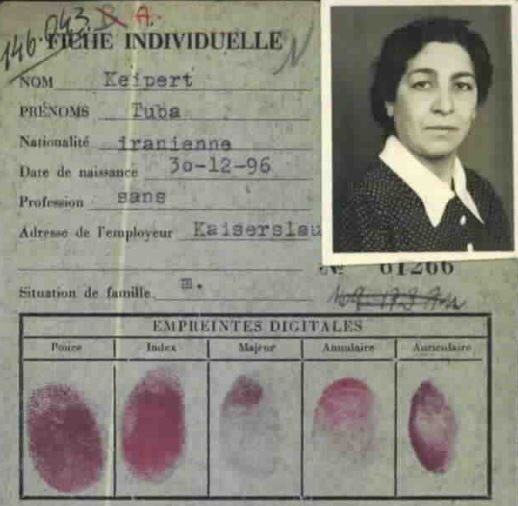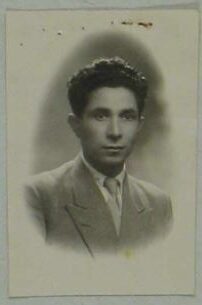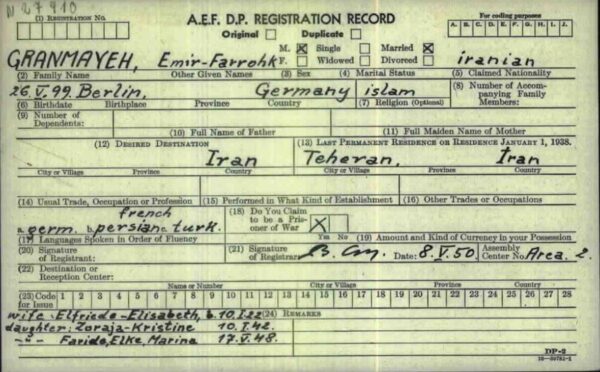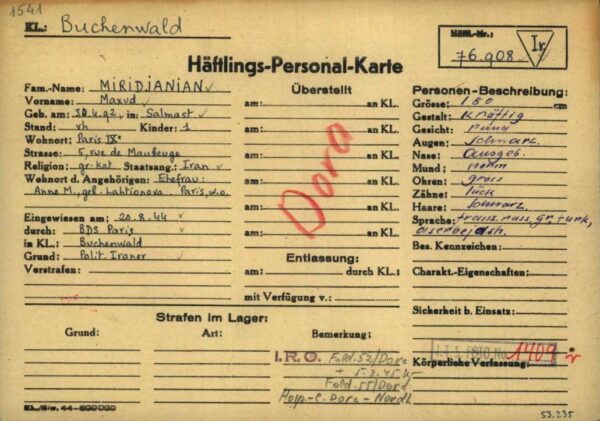International research cooperation tells the stories of Iranian victims of Nazi persecution

The Sardari Project: Iran and the Holocaust, developed by the Museum and IranWire.com, creates and distributes Persian-language multimedia content to counteract Iranian state-sponsored Holocaust denial, antisemitic rhetoric and restrictions on accurate information about the Holocaust.
WASHINGTON — The United States Holocaust Memorial Museum and IranWire.com, in cooperation with the Arolsen Archives, the world’s largest repository of information on Holocaust victims and survivors, have launched the latest installment of its Sardari Project: Iranian victims of Nazi persecution.
“The Holocaust was an event of worldwide significance; Jews and other victims of the Nazis came from all corners of the globe,” said Tad Stahnke, William and Sheila Konar director of international educational outreach in the Museum’s Levine Institute for Holocaust Education. “Helping Iranians look into the historical connections with the Holocaust and Nazi racism is a key part of our effort to underline the global relevance of the Holocaust.”
Named for Abdolhossein Sardari, an Iranian diplomat in Paris who worked to aid Iranian and Central Asian Jews under Nazi occupation in occupied France, the project brings Holocaust education to Iranian audiences. The Iranian regime promotes a relentless stream of state-sponsored Holocaust denial and antisemitism, while preventing access to accurate resources on Holocaust history. The project responds by creating new resources in Persian especially for young Iranians and distributing them on IranWire’s popular social media and online channels.
The stories of at least 44 Iranian victims of Nazi Germany, located within the 200 million records of the Arolsen Archives in Bad Arolsen, Germany, include those of forced laborers, members of the resistance, and Iranian Jews imprisoned in concentration camps.
Some of the victims include:
Aga Hassan, who was brought into Soviet-occupation zones directly from northwestern Iran and from there to Nazi German-held territories like occupied Poland and Austria as a forced laborer.
Toboj Magammed, who was already in Europe as a farm worker and became a forced laborer under Nazi rule.
Emir Farrokh Granmayeh, born in Berlin and the son of the Iranian ambassador to Germany, who braved political opposition to the Nazis and thus found himself sent to the Sachsenhausen concentration camp.


Personal fates documented in the Arolsen Archives
The research collective has found information on 44 Iranian victims of Nazi persecution in the Arolsen Archives for this project so far, some of their stories have already been written up.
“Telling the personal stories of Iranian victims of Nazi persecution is very important to learn about the Holocaust,” said Floriane Azoulay, director of the Arolsen Archives, based in Bad Arolsen, Germany. “The Nazi government, which sought to eradicate all Jewish life, was based on exclusion, persecution of various groups and enslavement of many individuals. This included Iranians, whose fate is documented in our archives.”
Since launching in 2020, the Sardari Project has introduced Iranian audiences to Holocaust history through articles and videos on topics ranging from Nazi propaganda to Muslim rescuers as well as Anne Frank, fabricated texts like the “The Protocols of the Elders of Zion” and more. To date, Persian language content produced through the project has received more than 13 million views across multiple social media platforms.
Previous installments included Anne Frank: The Graphic Biography; features on young people and historians speaking about historical images that inspire them to reflect on Holocaust history; as well as little-known stories that connect Iran, Iranians, and the Holocaust, such as The Jolly Boys, a Polish Jewish jazz band that found refuge in Iran during World War II, Polish Jewish refugee children sheltered in Tehran and Iranian victims of the Nazis.
“At a time when we witness horrifying levels of antisemitism, Islamophobia and other kinds of hatred around the world, we at IranWire feel that it is our duty to discuss the lessons of the Holocaust, and how hate speech, hateful ideas and hateful regimes can cause unimaginable tragedies,” said Maziar Bahari, IranWire.com founder. “The Islamic Republic is the only regime whose leaders regularly deny the Holocaust and invest millions of dollars every year in producing Holocaust denying and antisemitic productions. We are proud to be the only media outlet in the Middle East to regularly produce articles, videos, and other types of content about the crimes of the Nazi regime and its allies and their victims.”
About The Sardari Project
The Sardari Project: Iran and the Holocaust, a partnership of the U.S. Holocaust Memorial Museum and IranWire.com, seeks to engage with young Iranians about the history and lessons of the Holocaust, the dangers of unchecked hatred, conspiracy theories, propaganda, and more. The Iranian government prevents Iranians from learning about the Holocaust, including to their country’s unique connection to this history. During World War II, Nazi Germany targeted Iran for its resources, and Allied forces invaded and occupied the country. Iran accepted some 116,000 Polish refugees and army personnel fleeing horrible conditions in labor camps in the Soviet Union. Among the civilians were 1,000 Jewish children, the majority of them orphans.
About the United States Holocaust Memorial Museum
A federally chartered, nonpartisan educational institution, the United States Holocaust Memorial Museum serves as America’s national memorial to the victims of the Holocaust. The Museum is dedicated to ensuring the permanence of Holocaust memory, understanding, and relevance and inspires leaders and individuals worldwide to confront hatred, prevent genocide, and promote human dignity. For more information, visit ushmm.org.
About IranWire
Since its start in 2013, IranWire has become one of the most popular Persian language news websites inside and outside of Iran. Similarly, IranWire English has become required daily reading for tens of thousands of people around the world who want to have a better understanding of the country. The site is a joint venture of a group of Iranian journalists in the diaspora who started the site to empower young citizen journalists by creating a forum in which they can discuss local and international news.
About the Arolsen Archives
The Arolsen Archives are the world’s largest archive on the victims and survivors of Nazi persecution. The collection has information on about 17.5 million people and belongs to UNESCO’s Memory of the World. It contains documents on the various victim groups targeted by the Nazi regime and is an important source of knowledge for society today.
Portrait of Aga Hassan, Iranian forced laborer
(https://collections.arolsen-archives.org/en/document/80305874)

Displaced person: Emir-Farohk Granmayeh, born in Berlin and the son of the Iranian ambassador to Germany, deported to Sachsenhausen concentration camp, later stranded in Prien, Bavaria
(https://collections.arolsen-archives.org/en/document/67228418)

Prisoner card issued for Maxud Miridjanian, an Iranian exile who was deported from Paris to Buchenwald concentration camp and later taken to Mittelbau-Dora, where prisoners had to perform forced labor underground for the armaments industry
(https://collections.arolsen-archives.org/en/document/6638344)


